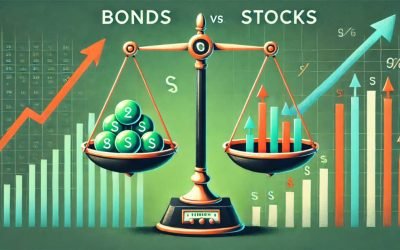Understanding the Basics of Stocks and Bonds
Investing is a crucial aspect of financial planning, and two of the most common investment vehicles are stocks and bonds. Both offer unique benefits and risks, making it essential to understand their differences before deciding where to allocate your funds. This article delves into the intricacies of stocks and bonds, providing a comprehensive comparison to help you make an informed decision.
What Are Stocks?
Stocks, also known as shares or equities, represent ownership in a company. When you purchase a stock, you buy a piece of that company, entitling you to a portion of its profits and assets. Stocks are traded on stock exchanges, and their prices fluctuate based on various factors, including the company’s performance, market conditions, and investor sentiment.
Types of Stocks
- Common Stocks: These stocks provide voting rights and potential dividends. They are the most prevalent type of stock.
- Preferred Stocks: These stocks offer fixed dividends and have priority over common stocks in the event of liquidation. However, they typically do not come with voting rights.
Benefits of Investing in Stocks
- Potential for High Returns: Stocks have historically provided higher returns compared to other investment options.
- Ownership and Voting Rights: As a shareholder, you have a say in the company’s decisions.
- Liquidity: Stocks can be easily bought and sold on stock exchanges.
Risks of Investing in Stocks
- Market Volatility: Stock prices can be highly volatile, leading to potential losses.
- Company Performance: Poor company performance can negatively impact stock prices.
- Economic Factors: Economic downturns can affect the entire stock market.
What Are Bonds?
Bonds are debt securities issued by governments, municipalities, or corporations to raise capital. When you purchase a bond, you are essentially lending money to the issuer in exchange for periodic interest payments and the return of the principal amount at maturity.
Types of Bonds
- Government Bonds: Issued by national governments, these bonds are considered low-risk investments.
- Municipal Bonds: Issued by local governments, these bonds often offer tax advantages.
- Corporate Bonds: Issued by companies, these bonds typically offer higher yields but come with higher risk.
Benefits of Investing in Bonds
- Steady Income: Bonds provide regular interest payments, offering a stable income stream.
- Lower Risk: Bonds are generally considered less risky than stocks.
- Diversification: Including bonds in your portfolio can help diversify your investments and reduce overall risk.
Risks of Investing in Bonds
- Interest Rate Risk: Bond prices can fall if interest rates rise.
- Credit Risk: The issuer may default on interest payments or fail to return the principal amount.
- Inflation Risk: Inflation can erode the purchasing power of bond interest payments.
Comparing Stocks and Bonds
To make an informed investment decision, it’s essential to compare stocks and bonds across various parameters. This section provides a detailed comparison to help you understand the key differences and similarities between these two investment options.
Returns
Stocks have the potential for higher returns compared to bonds. Historically, the average annual return for stocks has been around 7-10%, while bonds have provided returns in the range of 3-5%. However, higher returns come with higher risks, and stock prices can be highly volatile.
Risk
Bonds are generally considered less risky than stocks. Government bonds, in particular, are viewed as low-risk investments. However, corporate bonds carry higher risk due to the potential for issuer default. Stocks, on the other hand, are subject to market volatility, company performance, and economic factors, making them riskier investments.
Liquidity
Stocks are highly liquid investments, as they can be easily bought and sold on stock exchanges. Bonds, while also relatively liquid, may not be as easily traded, especially if they are not widely held or if market conditions are unfavourable.
Income
Bonds provide regular interest payments, offering a steady income stream. Stocks may also provide income through dividends, but these payments are not guaranteed and can fluctuate based on the company’s performance.
Diversification
Including both stocks and bonds in your investment portfolio can help diversify your investments and reduce overall risk. Stocks offer growth potential, while bonds provide stability and income. A well-diversified portfolio can help you achieve a balance between risk and return.
Factors to Consider When Choosing Between Stocks and Bonds
When deciding whether to invest in stocks or bonds, it’s essential to consider various factors that can influence your investment strategy. This section outlines key factors to help you make an informed decision.
Investment Goals
Your investment goals play a crucial role in determining whether stocks or bonds are more suitable for you. If your primary goal is capital appreciation and long-term growth, stocks may be a better option. However, if you seek steady income and capital preservation, bonds may be more appropriate.
Risk Tolerance
Your risk tolerance is another critical factor to consider. If you are comfortable with higher risk and potential market volatility, stocks may be a suitable choice. Conversely, if you prefer lower risk and more stable returns, bonds may be a better fit.
Time Horizon
Your investment time horizon can also influence your decision. If you have a long-term investment horizon, you may be able to ride out market fluctuations and benefit from the growth potential of stocks. However, if you have a shorter time horizon, bonds may be more appropriate due to their lower risk and stable returns.
Current Market Conditions
Market conditions can impact the performance of both stocks and bonds. During periods of economic growth, stocks may perform well, while bonds may offer lower returns. Conversely, during economic downturns, bonds may provide more stability and protection against market volatility.
Building a Balanced Investment Portfolio
A well-balanced investment portfolio typically includes a mix of stocks and bonds to achieve a balance between risk and return. This section provides guidance on how to build a balanced portfolio that aligns with your investment goals and risk tolerance.
Asset Allocation
Asset allocation is the process of dividing your investment portfolio among different asset classes, such as stocks, bonds, and cash. The appropriate asset allocation depends on your investment goals, risk tolerance, and time horizon. A common rule of thumb is to allocate a higher percentage of your portfolio to stocks when you are younger and gradually increase the allocation to bonds as you approach retirement.
Rebalancing Your Portfolio
Rebalancing involves adjusting your portfolio’s asset allocation to maintain your desired risk level. Over time, the performance of different asset classes can cause your portfolio to drift from its original allocation. Regularly rebalancing your portfolio can help you stay on track and ensure that your investments align with your goals and risk tolerance.
Diversification
Diversification involves spreading your investments across different asset classes, sectors, and geographic regions to reduce risk. By diversifying your portfolio, you can mitigate the impact of poor performance in any single investment. Both stocks and bonds offer opportunities for diversification, and including a mix of both can help you achieve a balanced portfolio.
Conclusion
Choosing between stocks and bonds depends on various factors, including your investment goals, risk tolerance, time horizon, and current market conditions. Stocks offer the potential for higher returns but come with higher risks, while bonds provide steady income and lower risk. A well-balanced investment portfolio typically includes a mix of both stocks and bonds to achieve a balance between risk and return.
By understanding the differences between stocks and bonds and considering your unique financial situation, you can make an informed decision that aligns with your investment objectives. Remember to regularly review and rebalance your portfolio to ensure it continues to meet your goals and risk tolerance.

Q&A Section
1. What are the main differences between stocks and bonds?
Stocks represent ownership in a company and offer potential for high returns but come with higher risks. Bonds are debt securities that provide steady income and lower risk but typically offer lower returns compared to stocks.
2. How do I decide whether to invest in stocks or bonds?
Consider your investment goals, risk tolerance, time horizon, and current market conditions. Stocks may be suitable for long-term growth and higher risk tolerance, while bonds may be better for steady income and lower risk tolerance.
3. Can I include both stocks and bonds in my investment portfolio?
Yes, including both stocks and bonds in your portfolio can help diversify your investments and achieve a balance between risk and return. A well-balanced portfolio typically includes a mix of both asset classes.
4. What is asset allocation, and why is it important?
Asset allocation is the process of dividing your investment portfolio among different asset classes, such as stocks, bonds, and cash. It is important because it helps you achieve a balance between risk and return based on your investment goals, risk tolerance, and time horizon.
5. How often should I rebalance my investment portfolio?
Rebalancing your portfolio involves adjusting your asset allocation to maintain your desired risk level. It is generally recommended to review and rebalance your portfolio at least once a year or whenever there are significant changes in market conditions or your financial situation.
Here are a few insightful articles comparing stocks and bonds:
- NerdWallet provides a beginner-friendly guide explaining the fundamental differences between stocks and bonds. Stocks give you partial ownership in a company, with the potential for high returns, but at higher risk. Bonds, on the other hand, are loans to a company or government, offering more stability but lower returns. The article highlights how these assets fit into different investment strategies, depending on risk tolerance and financial goals (NerdWallet: Finance smarter).
- MasterClass emphasizes the balance between stocks and bonds in a well-diversified portfolio. Stocks tend to offer higher returns over the long term, while bonds provide a reliable income stream with lower volatility. The article suggests how understanding the differences between these asset classes can help investors achieve a better balance in their portfolios (MasterClass).
- Investopedia delves into the nuances of the bond and stock markets. It covers how stocks represent equity and involve greater risk, while bonds are debt instruments with more predictable returns. The article also compares the risk-reward profiles of both, offering insights into when each type of asset might be appropriate based on market conditions (NerdWallet: Finance smarter).
These articles provide a thorough comparison of stocks and bonds, helping you to make more informed investment decisions.















 How to trade CFD? (00:49)
How to trade CFD? (00:49) How to trade binary options*? (01:22)
How to trade binary options*? (01:22) Forex. How to start? (01:01)
Forex. How to start? (01:01)